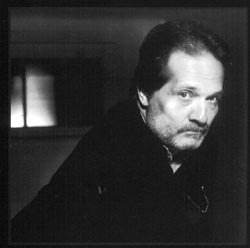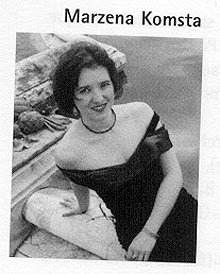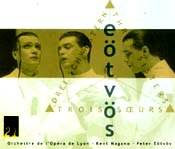Triangel Ensemble Intercontemporain/ Jonathan Nott with
Michel Cerutti (percussion) 22 September 2001 Palais de Fêtes
Windsequenzen Accroche Note and musikFabrik/Philippe
Nahon 3 October, ZKM Karlsruhe, Germany.
Brass: The Metal Space Ensemble Brass in the Five, 6
October, Museum of Contemporary Art
Septieme Porte (film portrait of Peter Eötvös
by Judit Kele, 6 October, Museum of Contemporary Art
Atlantis SWR Radio-Sinfonieorchester/Peter Eötvös
6 October, Palais de Musique et des Congres (PGW)

[PICT Peter Eötvös
(photo Marthe Lemelle)]
Peter Eötvös (b.1944) grows in stature with exposure in
depth to his richly varied oeuvre, and Musica has done
well to feature him handsomely in a generous retrospective at Strasbourg.
In the very desirable programme book there is a five-page article about
Eötvös which, in discussing his Triangel, notes how
its air of 'anti-authoritarian autonomy' reflects the spirit of the
'60s. He continues to explore relationships of sound and structure,
and those between performers and audience, and each of the pieces we
heard had a spirit of adventure.
Triangel (1993) was the first of six
works (plus a film) which were given in separate events throughout the
festival. Triangel has been recommended to previously MusicWeb
readers on CD (BIS
948), but was infinitely more exciting experienced live. It is a
major work for a large ensemble of 27 instruments, lasting over 40 mins,
with a dominant 'creative' percussionist, Michel Cerutti, who acted
as a master of ceremonies, as in African drumming, moving around the
stage and freed by the composer to take musical decisions during the
performance and determining 'tasks' for each group in turn.
Triangel begins with an offstage tinkling and
a sole player entering, making apparently desultory sounds on the triangle
he carries. Other instrumentalists enter from time to time and regroup
to play successive sections from different parts of the platform. In
one section Cerutti brings in eight wind soloists, each appearing to
improvise individually in turn and continuing to do so collectively,
the process initiated upon Cerutti's signals on metal plates ranged
between them. In another section strings, in groups of three from high
to low, were energised by Cerutti successively on three steel drums,
making a piquant contrast of timbre, building up to a powerful climax
involving the whole ensemble. Later Cerutti had a tremendous tympani
solo and towards the end of the work a passage that concentrates upon
dazzling resonances from three amplified triangles. A great concert
work, and one which would be ideal for video or DVD.
Eötvös's Windsequenzen (1975-1987),
given by the combined ensembles of Accroche Note (Strasbourg)
and musikFabrik (Dusseldorf), made for a satisfying culmination
of a cultural exchange evening of variable quality, across the border
in Germany.
The entire Strasbourg-based audience was transported
free of charge in four coaches, and supplied with food boxes on every
seat, to the Centre for Arts and Media Technology (ZKM) in Karlsruhe.
This was a former converted munitions factory, which had survived heavy
bombing of the city, and has been converted into a multi-purpose arts
centre with three serviceable auditoria, in two of which the groups
had each given short concerts earlier.

FromAccroche Note, the young Polish composer Marzena Komsta's
Journal en rafales (papers flying into the air in whirlwinds)
showed an individual quality to make her name one to look out for. A
video/electronic creation by the Portuguese Paolo Ferreira-Lopes held
attention with its audio-visual competence, and as a good vehicle to
admire Françoise Kubler's voice and magnetism, her image discernible
from behind the screen; however, it has to be said again that some of
the abstract images, sweeping repetitively up and across the large screen,
showed little advance upon familiar computer screen-saver patterns,
as had been the case with earlier video presentations during the festival.
Windsequenzen comprised a series of sections,
framed by Calme I and Calme II, twenty minutes later.
The intervening music was given poetic titles by Eötvös, added
after its completion, with sequences of morning wind, mountain wind,
whirlwind and sea winds from different points of the compass. The spirit
of the work is one of serenity expressed in harmonic movement, its essence
'impregnated with the paradoxes of Zen Buddhism; serenity within movement
& movement within serenity - immobility which contains within itself
the possibility of movement, a readiness for something to happen'. The
instrumentation is unique, with flute, oboe/cor anglais, 2 clarinets
+ bass clarinet, double bass, tuba, percussion and harmonium. There
is a long flute solo - the wind instrument closest to the natural sounds
of wind itself - and later a trio passage for flute, tuba and harmonium!
The oboist has an additional role as vocalist, evoking the wind itself
by blowing gently through his lips into a microphone, producing sibilant
sounds which were neither singing nor whistling; far more convincing
in a musical context than the usual orchestral wind-machine. A truly
unique 'one-off', unlike any other music, and just the sort of thing
one looks for in a festival.
Peter Eötvös dominated the last day
of Musica 2001. In the afternoon, at the Museum of Contemporary Art,
the film portrait Septieme Porte by Judit Kele (1998) was shown
in the composer's presence. The title's allusion is to the secrets of
Bluebeard (we see him  conducting
the Bartok opera) and to 'un artist aussi secret', to whose very private
composing room we were taken, where in isolation he creates his music
with just a small piano for company. There are shots of Eötvös
working with Stockhausen, and rehearsal extracts from his important
opera The Three Sisters, those roles taken by three counter-tenors.
Its world premiere in 1998 is available on a lavishly produced and highly
recommendable live recording [DG
459 694-2].
conducting
the Bartok opera) and to 'un artist aussi secret', to whose very private
composing room we were taken, where in isolation he creates his music
with just a small piano for company. There are shots of Eötvös
working with Stockhausen, and rehearsal extracts from his important
opera The Three Sisters, those roles taken by three counter-tenors.
Its world premiere in 1998 is available on a lavishly produced and highly
recommendable live recording [DG
459 694-2].
In the gallery's main central space the Budapest Ensemble
Brass in the Five gave two performances of Eötvös's "jeu
acoustique" Brass: The Metal Space. This event was close to my
heart and to a long-standing preoccupation of Seen&Heard. 'Sound
that you hear is the sum of the sound of the instrument and of the space
in which it is heard', writes Eötvös and this composition
explores in a multiplicity of demonstrations how sound is changed by
moving the sound source around. Between the two performances there was
a lecture-demonstration by Janos Pap, Professor of Acoustics in Budapest,
which underlined my interest in the importance of concert hall acoustics
(see Sound
in Silence, Lucerne) and my contention that reviews which
aim to assess performances with some objectivity in certain halls may
need to specify where the critic was sitting, which can make a huge
difference to the overall effect of a concert performance.
Sitting close to the players for the first rendering
of Brass: The Metal Space some of the intended differences were
minimised, because most of the sound was received from the instruments
direct; high up under the roof for the repeat performance, all the intended
effects came vividly to life. This entertaining composition has a real
value in encouraging concert goers to 'ouvrez bien vos deux oreilles',
as Eötvös writes, and would be a huge success if introduced
in concerts for young people.
To conclude the whole festival, Peter Eötvös
conducted the Stuttgart based SWR Radio-Sinfonieorchester in a revival
of his Atlantis (1995) at the huge concert hall of the
Palais de Musique et des Congres. For Eötvös, Atlantis
symbolises terrifying natural catastrophe and also signifies social
and ethical conflicts which manifest themselves; like Atlantis, he places
the audience 'under the sea' as the work commences, surrounded by his
'fantastic sonic universe'. The eight percussionists are placed around
the stage and three distributed around the back of the auditorium. There
are five electronic keyboard instruments and live electronics spread
the sound around us impressively. A moderate sized orchestra is called
for otherwise, with only ten strings but some unusual wind instruments,
including double-bass tuba, and an important part for cimbalom (Marta
Fabian).
The text by Sandor Weöres was not supplied in
any language (a similar lack was even more crippling for Luca Francesconi's
new work in the first half, a massive and relentlessly loud modernist
score with declamation of text by a reciter almost throughout, mainly
in Italian). Two remarkable singers took part in Atlantis and
one could enjoy them without knowing what they were on about - Gregor
Dalal, baritone - but he sang also falsetto in the counter tenor range
- and a confident unnamed boy who offered splendidly controlled tone
and long, smooth glissandi with impressive aplomb. I had not come across
this work, which is said to be available on CD (?), but that could not
be any substitute for experiencing it in a suitable space; Atlantis
would be well received at one of the Barbican's contemporary music
showcases, and would sound magnificent at the Royal Albert Hall. But
this must be a costly score to mount and Musica must be congratulated
in organising so spectacular a finale for the festival - and inviting
the whole audience afterwards to an open buffet with wine for us to
take our farewells.
Peter Grahame Woolf


 Return to:
Music on the Web
Return to:
Music on the Web